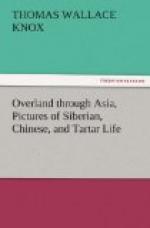One large building with a yard in front and an inscription over its gate was pointed out as a government office. Several employees of the Emperor of China were standing at the gateway, all smoking and enjoying the evening air. At a hitching post outside the gate there were three saddled horses of a breed not unlike the ‘Canadian.’ The saddles would be uncomfortable to an American, cavalry officer, though not so to a Camanche Indian. According to my recollection of our equestrian savage I think his saddle is not much unlike the Mongolians’.
Beyond this establishment we entered a yard in front of a new and well-built house. Near the door was the traveling carriage of the governor of Igoon, who had arrived only an hour or two before. The carriage was a two-wheeled affair, not long enough to permit one to lie at full length nor high enough to sit bolt upright. It had no springs, the frame resting fairly on the axles. The top was rounded like that of a butcher’s cart and the sides were curtained with blue cloth that had little windows or peep-holes. I looked behind the curtain and saw that the sides and bottom were cushioned to diminish the effect of jolting. Two or three small pillows, round and hard, evidently served to fill vacancies and wedge the occupant in his place.
[Illustration: MANJOUR TRAVELING CARRIAGE.]
The shafts were like those of a common dray, and the driver’s position was on a sort of shelf within ten inches of the horse’s tail. There was room for a postillion on the shelf with the driver, the two sitting back to back and their legs hanging over the side. The wheel-tires were slightly cogged as if made for use in a machine, and altogether the vehicle did not impress me as a comfortable one. Being without springs it gives the occupant the benefit of all jolting, and as the Chinese roads are execrable, I imagine one might feel after a hundred miles in such a conveyance very much as if emerging from an encounter with a champion prize-fighter.
Sometimes the Chinese officials set the wheels of their carts very far aft so as to get a little spring from the long shafts. Even with this improvement the carriage is uncomfortable, and it is no wonder that the Chinese never travel when they can avoid it.
Entering a hall that led to a larger apartment, we reached the presence of the governor of Igoon. He was seated on a mat near the edge of a wide divan, his legs crossed like a tailor’s at his work. He was in a suit of light-colored silk, with a conical hat bearing a crystal ball on the top. It is generally understood that the grade of a Chinese official may be known by the ball he wears on his hat. Thus there are red, blue, white, yellow, green, crystal, copper, brass, et cetera, according to the rank of the wearer. These balls take the place of the shoulder-strap and epaulettes of western civilization, and it must be admitted that they occupy the most conspicuous position one could select. As I am not versed in details of the orders of Chinese rank I will not attempt to give the military and civil status of my new acquaintance. I learned that he was a general in the army, had displayed skill and bravery in subduing the rebellion, and been personally decorated by the Emperor.




